The Persian Origins Of Cookies
Whether chocolate chip, ginger snap, or snickerdoodle, cookies are an essential part of the American food landscape. Even though cookies may evoke memories of summers spent in your grandma's kitchen, their history goes back much further.
According to historians, the ancestors of modern cookies first appeared in 7th century Persia, in what is now modern-day Iran. While we think of cookies today as a dessert all on their own, the first cookies were created as a way to test the temperature of ovens. In order to make sure baking conditions were just right, a small amount of batter would be placed into an oven to ensure the perfect temperature was achieved before the rest of the batter could be baked into a full-sized cake.
Important events of the 7th century such as the Muslim conquest of Spain and the beginning of the Crusades in the 11th century helped introduce the Persian cookie precursors to Europe. The pastries took hold amongst the cultures of medieval Europe, becoming increasingly popular. By the time of the Renaissance, cookies had started to pop up in cookbooks.
The first settlers brought cookies to America
While cookies may have started in Persia, they became a favored part of American cuisine. European colonists brought some of their most important cultural foods, including recipes for cookies, to America. By the 1930s, most of the modern cookie varieties we recognize today appeared on the American baking scene. Perhaps the most famous cookie variety, the chocolate chip cookie, was cooked up by Toll House restauranteur Ruth Wakefield in 1937.
The popularity of chocolate chip cookies helped propel cookies into the cultural zeitgeist, forever solidifying their place in American cuisine. Over eight decades later, cookies are still a much-loved part of American culture, with chocolate chip cookies still sitting in first place in terms of popularity, per the New York Post.
Meanwhile, cookies are also present in their ancestral birthplace as well. In modern-day Iran, the dessert has several distinct variations, quite different from anything served in America. The koloocheh is a traditional Persian cookie, made from flour and butter and includes cinnamon and nuts. It's traditionally served as part of Nowruz celebrations (a spring celebration in Iran). Meanwhile, the nan-e berenji is a light cookie, made with rice flour. No matter the cultural differences, cookies are indeed a global snack.

